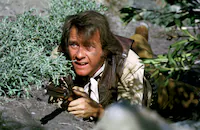An atmospheric and steamy neo-noir, Body Heat (1981) is an impressive feature directorial debut by Lawrence Kasdan. Inspired by Kasdan’s love of film noir, specifically movies like The Big Sleep (1946), Out of the Past (1947) and The Asphalt Jungle (1950), Body Heat pays homage to the film noir style while boosting its sex appeal for a contemporary audience. The basic premise of a femme fatale and her lover plot to murder her wealthy husband was modelled from the noir Double Indemnity (1944). In Kasdan’s original screenplay, that premise takes on a whole new life with two new unsympathetic protagonists, a Florida setting and an unrelenting heatwave. William Hurt plays Ned Racine, a sleazy lawyer whose lust for a married woman lands him in hot water. Matty Walker, played by Kathleen Turner, is the object of his obsession and lures him into a plot to murder her investor husband Edmund (Richard Crenna).
Lawrence Kasdan’s screenwriting career was on the rise thanks to his collaborations with George Lucas on two of the original Star Wars movies and Raiders of the Lost Ark (1981). Kasdan took inspiration from his favorite filmmakers, John Sturges and Akira Kurosawa, as well as his favorite classic movies to update those styles of filmmaking with a fresh perspective. He presented his idea for Body Heat to Alan Ladd Jr., the head of 20th Century-Fox, who was interested in the project and put in on the books. When Ladd left the studio to start The Ladd Company, Kasdan’s script languished at Fox. According to the AFI, Fox dropped the project when a disagreement on casting couldn’t be resolved. Ladd was still interested in taking on Body Heat but felt that having a first-time director on the project would be a gamble. They reached an agreement that if Kasdan were to fail he would immediately be replaced by a more experienced director. George Lucas secretly signed on as guarantor, offering to pay a fee if Kasdan went over budget.
It was obvious that there was little confidence in Kasdan’s abilities. This had an effect on him and eventually influenced how he made Body Heat. If this was going to be his only opportunity to direct a film, then he would employ every filmmaking technique, especially those from film noir, that he wanted to try. Knowing full well that having a male director and male cinematographer, Richard H. Kline, might steer the film into becoming just another male fantasy, Kasdan hired Carole Littleton as the film editor to get a female perspective, especially when it came to the many sex scenes.
Kasdan insisted on casting unknowns in order to give the audience an opportunity to discover great talent for the very first time. Every character was complex, intriguing and kept audiences guessing. Even minor characters had to have some sort of captivating quality. Casting the right people was essential. The role of Matty Walker was carefully modeled in the image of 1940s era Lauren Bacall, and Kathleen Turner fit the bill. She had the sultry voice, the figure and the charisma to play the part. However, there was resistance to casting Turner because she had no previous film acting experience. According to the Los Angeles Times, New York casting agents refused to let her audition. It was when she auditioned for another film entirely, All the Marbles (1981), that she caught the eye of casting agent Wally Nicita, who offered her the script. Turner did a test with actor William Hurt and the two had such great chemistry on screen that they were cast as the leads.
Other newcomers included Mickey Rourke, in an early film role as the film’s arsonist, and Ted Danson, in his second film role as lawyer Peter Lowenstein. Danson was a year out from his breakout role on the TV show Cheers (1982). His character provides comedic relief in the film, and he even performs a Fred Astaire-inspired dance sequence. Kim Zimmer, Kathleen Turner’s replacement on the soap opera The Doctors, was cast because of her striking resemblance to Turner, which provided an important plot twist. Richard Crenna was one of the few established actors. Coincidentally, he played insurance agent Walter Neff in the 1973 TV movie remake of Double Indemnity and was now playing the murder victim instead.
Production for Body Heat got off to a rocky start. Filming was set to begin August 1980 on the Jersey Shore. However, due to a Screen Actors Guild strike, the production had to be moved to Lake Worth, Florida. The delays pushed back filming to November 1980 when Florida was experiencing an unusually cold winter. The crew implemented various elements to depict a heatwave, including adding steam, running fans, spraying actors with water and using other visual cues. In an interview for the Blu-ray release, Kathleen Turner said that she would hold an ice cube in her mouth shortly before shooting a scene so the condensation wouldn’t show on screen when she spoke. Despite the challenges, filming moved forward. The final scene was shot in Kauai, Hawaii, and additional retakes were completed at the Zoetrope Studios in Los Angeles.
Body Heat premiered August 28, 1981 and then nationwide to 730 theaters on September 18. It became the 33rd highest-grossing film of that year earning $24 million dollars. It won over many critics. Vincent Canby of The New York Times called it “the steamiest, most thoroughly satisfying melodrama about love, lust and greed to be seen since Billy Wilder's ‘Double Indemnity.’” Kasdan was lauded for his skills as a first-time director, which genuinely took him by surprise. Body Heat put William Hurt, Kathleen Turner and Ted Danson on the map and is recognized as one of the most enticing neo-noir of the 1980s.



















